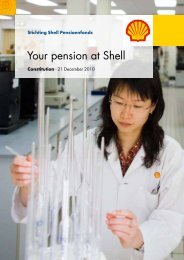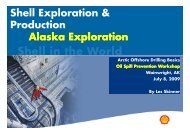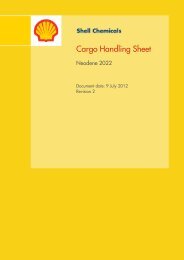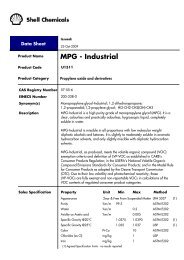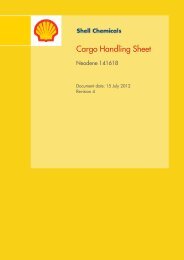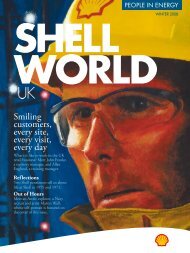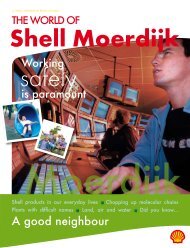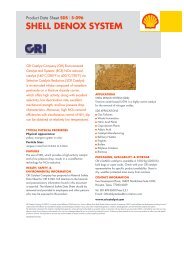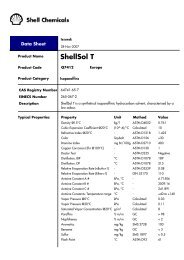Part 1
Part 1
Part 1
Create successful ePaper yourself
Turn your PDF publications into a flip-book with our unique Google optimized e-Paper software.
DEVELOPMENTS IN ENGINETECHNOLOGYJIM ELFTERHIGH HORSEPOWER DIVISIONAL FIELD SERVICE ENGINEERCopyright © 2000-2012 Cummins Inc. All rights reserved. Presented at the Shell Technology Forum, October 2012
CUMMINS DIESEL ENGINE COMPARISONS OVER TIMEMeeting the demands of customersCopyright © 2000-2012 Cummins Inc. All rights reserved. Presented at the Shell Technology Forum, October 2012
EVOLUTION OF KEY TECHNOLOGIESMaking the metal work harder Making the metal work smarter Making the metal work cleanerNaturallyAspiratedTurboCharging1978NOx = 10g/HP-hr<strong>Part</strong>iculate = 1.0g/HP-hrAir-Air Charge CoolingElectronics• Full Authority• Smart Actuators• Vehicle Integration2010NOx = 0.2g/HP-hr<strong>Part</strong>iculate = 0.01g/HP-hr(On – Highway only)Air Handling, FuelSystems• 2-Stage T/C• Common rail• DPF/DOC1950s 1960s 1970s 1980s 1990s 2000s 2010sMaking engines cleaner while improving fuel efficiencyEGR – Exhaust Gas Recirculation, VGT - variable geometry turbo-charging, DPF – Diesel <strong>Part</strong>iculate Filter, DOC – Diesel Oxidation Catalyst, SCR – Selective Catalytic ReductionCopyright © 2000-2012 Cummins Inc. All rights reserved. Presented at the Shell Technology Forum, October 2012
NOx + HC (g/kW-hr)EVOLUTION OF KEY TECHNOLOGIES - OFF-ROAD15EPA MOH Tier 4 > 751 bhpUnregulated1050Tier 2 (2006)Tier 1 (2000)Tier 4 Interim (2011)Tier 4 Final (2015)0.1 0.5 1.0Tier 1• Tier Regulations 2 introduced• Injection Combustion timing trade-off retardation more difficult• Combustion optimization• Tier Advanced 4 Interim fuel systems• Aftertreatment introducedTier • SCR 4 or Final CEGR technology• Since Tier 1 - reduced 62% NOx & 93% PM• Technology to be determinedAt Tier 4 Final NOx and PM at insignificant levelsCEGR – Cooled Exhaust Gas Recirculation, SCR – Selective Catalytic Reduction, DPF – Diesel <strong>Part</strong>iculate Filter, PM – <strong>Part</strong>iculate Matter, NOx – Oxides of NitrogenPM (g/kW-hr)Copyright © 2000-2012 Cummins Inc. All rights reserved. Presented at the Shell Technology Forum, October 2012
NOx + HC (g/kW-hr)EVOLUTION OF KEY TECHNOLOGIES - OFF-ROADEPA MOH Tier 4 > 751 bhp1510Tier 1 (2000)Tier 4 Final• Presents the most significant changein diesel engine technology in recenthistory for HHP engines.5Tier 2 (2006)Tier 4 Interim (2011)Tier 4 Final (2015)• Aftertreatment is the most likely optionto meet these very low levels in 2015– development work for emissionssolutions is ongoing….00.1 0.5 1.0PM (g/kW-hr)Proven on-highway technology will be introduced into off-highwayCEGR – Cooled Exhaust Gas Recirculation, SCR – Selective Catalytic Reduction, DPF – Diesel <strong>Part</strong>iculate Filter, PM – <strong>Part</strong>iculate Matter, NOx – Oxides of NitrogenCopyright © 2000-2012 Cummins Inc. All rights reserved. Presented at the Shell Technology Forum, October 2012
EMISSIONS REGULATIONS - OFF-ROAD (PHASE-IN)Worldwide Nonroad Emission Regulations - Timing for Initial Year of Phase-in2008 2009 2010 2011 2012 2013 2014 2015U.S. EPA / Canada Tier 3 Tier 4i (Proposed 2012 in Canada) Tier 4fEU Stage IIIAStage IIIB Stage IVECE (Eastern Europe) Effect dates can vary by country, but can be no earlier than dates shown.20162017 2018Japan (JMLIT) Tier 3 Tier 4a Tier 4b?South Korea Tier 2 Tier 3 Tier 4i? Tier 4f?China Stage I Stage II Proposed Stage III (EU IIIA) Proposed Stage IV (EU IIIB)?India - Const. India BS II (EU Stage I) India BS III (EU Stage IIIA)India - AgSimilar to EU Stage IRussiaBrazilStage IIProposed MAR-I (Stage IIIA); ag lags by 2 yrChile Proposed Stage II - Santiago const Proposed alignment with BrazilSingapore Tier 1 / Stage I / JMLIT Tier 1 Proposed Tier 2 / Stage II / JMLIT Tier 1?AustraliaNonroad regulation under developmentApproximate alignments : Tier 1 = Stage 1, Tier 2 = Stage II, Tier 3 = Stage IIIA, Tier 4i = Stage IIIB, Tier 4f = Stage IVDates generally reflect the earliest date for the phase-in of a particular level. Exceptions exist.Cummins well positioned to accept and support product required to meet emissions legislationRev: 5 July 2011Australia remains unregulated – but for how long?Copyright © 2000-2012 Cummins Inc. All rights reserved. Presented at the Shell Technology Forum, October 2012
LEADER OF INTEGRATED COMPONENT TECHNOLOGIESCombustionAftertreatmentFuel SystemsElectronic ControlsCopyright © 2000-2012 Cummins Inc. All rights reserved. Presented at the Shell Technology Forum, October 2012
LEADER OF INTEGRATED COMPONENT TECHNOLOGIESCombustionAftertreatmentFuel SystemsElectronic ControlsCopyright © 2000-2012 Cummins Inc. All rights reserved. Presented at the Shell Technology Forum, October 2012
DIESEL PARTICULATE FILTER (DPF)• Low Temperature Active Regeneration• Dosing Injector• Diesel Oxidation Catalyst (DOC)24• Wall-Flow Filter• Catalysed• High Efficiency Soot Filter• Ash & Soot Capacity• Durability / Fatigue Life3• Oxidation Catalyst• Passive Regeneration• HC Low TemperatureOxidationDPF is one of the possible Tier 4 Final solutionsCopyright © 2000-2012 Cummins Inc. All rights reserved. Presented at the Shell Technology Forum, October 20121• Active Engine• Thermal Management• Flexible Air & Fuel Systems• Exhaust Temperature Control• Exhaust Mass Flow ControlOxidation
SELECTIVE CATALYTIC REDUCTION (SCR)• Ammonia and catalyst transformNOx in exhaust into Nitrogen (N)& Water (H 2 O)• A „reductant‟ is added to theexhaust flow to create reaction incatalyst chamber• Liquefied urea is the bestchoice - AdBlue®• Proven in on-highway• Safe, clean, effective, availableSCR is one of the possible Tier 4 Final solutionsCopyright © 2000-2012 Cummins Inc. All rights reserved. Presented at the Shell Technology Forum, October 2012
COMBINATION SCR /DPF/DOCCombination is one of the possible Tier 4 Final solutionsEGR – Exhaust Gas Recirculation, DPF – Diesel <strong>Part</strong>iculate Filter, SCR – Selective Catalytic ReductionCopyright © 2000-2012 Cummins Inc. All rights reserved. Presented at the Shell Technology Forum, October 2012
LEADER OF INTEGRATED COMPONENT TECHNOLOGIESCombustionAftertreatmentFuel SystemsElectronic ControlsCopyright © 2000-2012 Cummins Inc. All rights reserved. Presented at the Shell Technology Forum, October 2012
Injection Pressure (Bar)EVOLUTION OF CUMMINS FUEL SYSTEMS36k psi ~350030002500Unit InjectorsCommon RailPump Line NozzleCELECTHPI-TPHigh PressureCommon Rail20001500PTMechanicalSystemsPT-STCElectronicSystemsXPI100050001950 1960 1970 1980 1990 2000 2010 2020YearHigh pressure common rail requires good fluid management practicesPT – Pressure Timing, PT-STC – PT Step Timing Control, CELECT – Cummins Electronic, HPI-TP – High Pressure Injection Timing Pressure, XPI – Extreme Pressure InjectionCopyright © 2000-2012 Cummins Inc. All rights reserved. Presented at the Shell Technology Forum, October 2012
LEADER OF INTEGRATED COMPONENT TECHNOLOGIESCombustionAftertreatmentFuel SystemsElectronic ControlsCopyright © 2000-2012 Cummins Inc. All rights reserved. Presented at the Shell Technology Forum, October 2012
COMBUSTION SYSTEM DESIGN• Complex interaction of combustion processes:• Complex Flows• Turbulence• Sprays• Combustion Chemistry• Needs to address customer requirementsfor increased efficiency while meetingregulatory requirements for emissionsregulationExtremely complex process to maximise efficiency and control emissionsCopyright © Cummins 2000-2012 Inc. Cummins Inc. All rights reserved. Presented at the Shell Technology Forum, October 2012 16
DIESEL COMBUSTION TESTINGSandia Cummins N14 HDD Optical EngineCombustion Simulation - Computer ModelingComputer modeling and simulation helps improve engine efficiencyCopyright © 2000-2012 Cummins Inc. All rights reserved. Presented at the Shell Technology Forum, October 2012
LEADER OF INTEGRATED COMPONENT TECHNOLOGIESCombustionAftertreatmentFuel SystemsElectronic ControlsCopyright © 2000-2012 Cummins Inc. All rights reserved. Presented at the Shell Technology Forum, October 2012
DUAL FUEL BASICS: HOW DOES IT WORK?Mixture of diesel fuel and natural gasNatural gas mixed with the intake airbefore the turbocharger compressor.Compression ignited diesel fuel is usedfor the ignition of the gas/air mixtureCan run on diesel only or a combinationof diesel and gas:• Between 0-90% natural gas• Must have some diesel to “pilot charge” ignitionCopyright © 2000-2012 Cummins Inc. All rights reserved. Presented at the Shell Technology Forum, October 2012
DUAL FUEL BASICS: HOW DOES IT WORK?Substitution rate varies with loadMaximum benefit when operating in the “sweet spot”Potential for significant operating cost savingsCopyright © 2000-2012 Cummins Inc. All rights reserved. Presented at the Shell Technology Forum, October 2012
EXTENDED SERVICE INTERVALS – HHP ENGINESExtend service intervals without compromising engine lifeCopyright © 2000-2012 Cummins Inc. All rights reserved. Presented at the Shell Technology Forum, October 2012
LIFE-TO-OVERHAUL (LTO)46% HP increase, 56% increase in HP/L & 56% increase in LTO – and risingTechnology, maintenance practices and oil analysis increase LTOCopyright © 2000-2012 Cummins Inc. All rights reserved. Presented at the Shell Technology Forum, October 2012
RESERVE OIL SYSTEMS (ROS)Allow extended engine service intervals when used withoil sampling and monitoringControls the oil level:• Circulates oil between the engine and supply tank• Continuous alternation between sump and ROSOil in ROS tank becomes part of the engine working oilLarger working oil volume slows the engine oildeterioration, in turn increasing the service intervalEngine oil service life increases in proportion to the increase inworking oil volumeCopyright © 2000-2012 Cummins Inc. All rights reserved. Presented at the Shell Technology Forum, October 2012
ELIMINATORFull-flow filterSeries of stacked discs with triple wire mesh elements for strength and durabilityThe filtered oil is passed back into the engine95% of the total flow is directed into the engine5% back flushes the full-flow elements, then:• Half passes direct to sump• Half passes through centrifugeSelf cleaning main element reduces maintenanceCopyright © 2000-2012 Cummins Inc. All rights reserved. Presented at the Shell Technology Forum, October 2012
CENTRIFUGE (SPINNER FILTER)Pressurised oil spins a rotor assemblyCentrifugal forces cause contaminates to migrateradically outwards to the inner surface of the rotor wall:• Over time, they compact to form a dense „cake‟• Cake can be removed at service intervalOperates in by-pass and processes approximately10% of lube oil before returning it to the engine‟s sumpDoes not rely upon filtration media to removecontaminantsRemoval of particles is based on relative density- not limited to particle sizeSimple and effective in reducing particle contaminationCopyright © 2000-2012 Cummins Inc. All rights reserved. Presented at the Shell Technology Forum, October 2012
SUMMARYEmissions regulations will drive significant change in mining enginesMuch of the Cummins technical development has been driven by on-highwayapplications and regulationsThe future focus is on efficiency improvements while meeting/exceeding the engineemissions regulationsTypes of energy options is rapidly changing – no longer just diesel• Biodiesel• Dual Fuel• Natural Gas – LNG / CNGChallenge is to ensure technology meets customer requirementsCopyright © 2000-2012 Cummins Inc. All rights reserved. Presented at the Shell Technology Forum, October 2012



